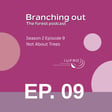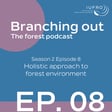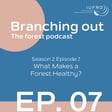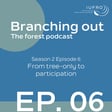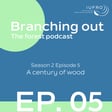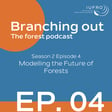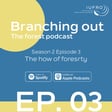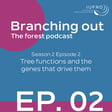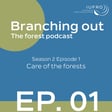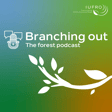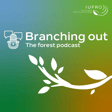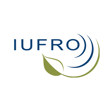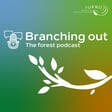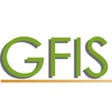Introduction to Wood as a Resource
00:00:04
Speaker
I'm a resource that's truly green, renewable, a wondrous scene. I capture carbon, a silent giver, while serving forests as a whole river. For me, textiles and packaging emerge. In tall wood buildings, I take the verge. Guess, what am I? So versatile and good. A material cherished, oh yes, I'm wood.
Podcast Introduction
00:00:31
Speaker
This poem was generated using chat GPT and recorded using speechify. Welcome back to Branching Out, the Forest Podcast, where we connect forests, science and people. Brought to you by the International Union of Forest Research Organizations, IUFRO. Let's discover the role of forests and trees for people and nature while we unravel complex forest topics and keep you up to date with forest
Exploring Forest Bioeconomics
00:01:00
Speaker
It's the third episode already. We have covered general information about the EUFRA World Congress 2024 in yesterfall and the first subtopic is trending for resilience and adaptation. Today is the time for responsible forest bioeconomics. Stick around to learn how forest bioeconomics plays a crucial role in carbon sequestration, mitigation of climate change, job creation and rural
Interview with Professor Anna Topinen
00:01:22
Speaker
development. I'm Jose Volanez from iUFRO and today with me is our co-host Ida Ballin from the Swedish Agricultural University, SLU. Welcome, Ida.
00:01:30
Speaker
Hi, thanks for having me Jose. Glad to be here for this super interesting episode about the bioeconomy. A while ago, I was part of a collaboration project before where we actually studied the social dimensions of a forest based bioeconomy in Europe. And it is great to return to the topic in the format of a podcast.
00:01:49
Speaker
In the Perform project, I had a great pleasure to collaborate with our first guest for today, Professor Anna Topinen from the University of Helsinki. She is a Congress keynote speaker for the theme towards a responsible forest bioeconomy. And she is here to put us in context. Let's start from the beginning. What is forest bioeconomy?
00:02:09
Speaker
Okay, there are naturally very many different types of definitions and a sort of narrow one would be that it's about transforming a variety of forest ecosystem services into bio materials and production of bio energy. Myself, I rather like relying more into the concept of circular forest bioeconomy, which is emphasizing transformation from a fossil fuel dependent economy towards
00:02:36
Speaker
more circular and bio-based economy. So it's about processes in which a virgin and recycled, bio-based forest resources are utilized more efficiently and hopefully in also a balanced way in these industrial processes to create value to society. And in order to claim to be responsible, of course, the demand for wood in production, it needs to be done within the ecological ecosystem boundaries.
Innovative Forest Products
00:03:01
Speaker
Forest bioeconomy extends beyond traditional wood products. Could you give us some examples of innovative and maybe surprising uses of forest resources? There are many of those, of course. One example comes to my mind coming from my own country Finland. It's called a wood cast. I don't know if you have heard about it. It's a medical cast made from wood chips and a biodegradable plastic.
00:03:23
Speaker
Another one I think is simply, I mean, this really new beautiful architectural designs of flagship buildings made of wood or libraries or school facilities made of wood. I think you see this popping up in many countries these days. So I think this is really something beautiful that's changing. And a third example that comes to mind. I think not too many days ago, I just saw a picture of paperboard and bottle introduced for a famous Swedish water cup brand.
00:03:52
Speaker
So i mean it's happening in the most innovative places one even knows if they speak off or they go mainstream but there are lots of lots of activities ongoing for sure.
Climate Change and Resource Use
00:04:03
Speaker
And what is needed as you mentioned to ensure a responsible use of these forest resources also in the face of climate change.
00:04:11
Speaker
Well, climate change is maybe only one of those big drivers. We also recognize biodiversity loss and limitations in using the natural resources in the face of growing population. So from an industrial perspective, this calls for, of course, developing new products, genuinely new products also to serve the needs of the people.
00:04:31
Speaker
But i would say that responsibilities also related to the meeting of the people's demands so these have also fundamentally changed you don't see and writing newspaper industry anymore or copy paper much used in offices or education as it is so it's about meeting the needs that are really crucial for people and also it's about dividing the profits and the revenues of these value creation processes in hopefully more equal and just manner.
00:05:01
Speaker
And like in the previous episode in the series, I think you were discussing resilience of forest systems. So I see also resilience of forest industrial system as a core element to produce responsibly goods and services. So that happens or should happen in resilient communities, helping adapt to economic, political or geopolitical shocks. So as a means of diversification of livelihoods is very important also here.
Global Bioeconomy Trends and Challenges
00:05:27
Speaker
Are we moving into the right direction? Do you see forest-based industries and societies worldwide move towards a low-carbon circular bioeconomy? I like to think positively that, yeah, there are signs that we are moving into the right direction. But the second question is, the chains are rapid enough in the light of all these challenges for having resilient forests and resilient forest value chains. I would say that there has been a lot of
00:05:54
Speaker
hype around new forest-based products, for example, to pharmaceutical industry to substitute chemicals or concrete or steel in urban construction sources. However, in reality, at the moment, the market shares of these new products are still pretty low. So the question is, I think this is a very important question, how to accelerate this change towards having more of these new products.
00:06:17
Speaker
In business research community, we talk with a concept called incumbent inertia. So the big multinational bulk and biomaterial companies, they are still getting the main revenue from these traditional quite price sensitive commodity products like bulk or paperboard. This may have an impact on how hard there is a push for genuinely striving for new products or focusing the business into recycling and reusing materials instead of putting focus on short term and single use products.
00:06:46
Speaker
I think as societies and as consumers, we should do a little bit more effort, definitely. Thank you.
Kenya's Biomass Energy and Indigenous Fruits
00:06:53
Speaker
Back to you, Jose, and more interesting examples from Kenya. Thanks, both of you, Anna and Ida. It's important to note that the examples may vary between different regions due to the diverse forest ecosystems, socio-economic conditions, and policy frameworks in the different countries.
00:07:10
Speaker
And we will have examples from Africa, Latin America, Asia. But before we go into that, because this is really connected, when we talk about forest bioreconomy, we normally talk about another concept, which is non-timber forest products. And our guests over here, we use this term many times. So these are things that are not necessarily wood. It could be nuts. It could be some other byproducts that are collected from the forest. And this non-timber forest products can actually impact the rural livelihoods.
00:07:40
Speaker
We are happy to welcome our next guest from the Kenyan Forest Research Institute and host of the World Congress in 2029. Welcome Nelly Edo, Director of the Forest Product Research Program, an expert in the field of biomass energy in the region. And she will provide some interesting examples, as you just said, Lida. Can you go ahead and provide us with information about the forest by economy in Kenya?
00:08:04
Speaker
Thank you so much for this chance to have this short podcast talking about forest by economy, forest products. We look forward, yes indeed definitely as Kefri is looking forward to hosting the AIFRA 2029. Definitely this is a region to look at.
00:08:19
Speaker
So some of the products that I can think of, because as a country, we are heavily dependent on biomass energy for not just domestic use, but for heating. And I've also seen that even for industrial use, the tea industry uses biomass energy, the fuel would, for treating the tea and also for processing vegetable oil for cooking. They also are using now biomass energy.
00:08:44
Speaker
And this is now contributing a lot of stress on the environment. So that's one of the things that we are using the forest products, especially in the biomass energy sector. And it's a huge percentage, over 70% of our trees go into all these particular sectors that I've mentioned. Yes, actually it goes almost to 90%. If you go to the rural areas, people are still using firewood and charcoal for cooking and heating. It's really highly dependent in the urban areas.
00:09:13
Speaker
could be now close to 80%, but we are trying to reduce that with other renewable energy items that we can be able to process. And do you know more examples from the region? Have you seen any positive outcomes from this initiative? We look at products that we can add value. Adding value is like the indigenous fruits.
00:09:32
Speaker
We're looking at medicinal plants and this will cause now the farmers to maintain these trees on firm because we are targeting to increase our tree cover on the land. When we get farmers to plant and to also maintain the tree species that they have, the indigenous fruit trees like the tamarinds, the baoba,
00:09:51
Speaker
So what we do is that because these are fruits that are in season seasonally, so when the farmers sell them, we tell them, okay, can you value add? Then that way you can not only just sell it as a raw product, but we are able to now actually, you can have now economy just at your place as much as instead of selling it as a raw product.
Baobab and Bamboo in Kenya's Economy
00:10:10
Speaker
So I have got examples like the baobab fruit that is indigenous in Africa and in Kenya in much of
00:10:17
Speaker
part of the eastern part of the country, these are huge trees. For a long time, some of the farmers were removing them from the land because they occupy a lot of space. But this specific fruit has one of the highest sources of vitamin C. In fact, it became so valuable, especially the powder, because it has seed and it's encased in a powder.
00:10:37
Speaker
These formed areas where we've got entrepreneurs, where we introduced them to farmer groups, that they could now be able to have that arrangement with the farmers, that they could be able to collect the fruit when it's in season, they would keep it in store, they would process it if it's not drying it, and then the entrepreneur if they are not
00:10:54
Speaker
are processing it on site. They'll take it where they can be able to process it, get the powder, and then the seed oil, the seed, once they've gotten the seed, the seed would be pressed and it's a highly valuable seed. The baobab oil is one of the expensive seed oils that we have that is used as a carrier for perfumery and also for cosmetics.
00:11:14
Speaker
So this also has formed micro industries and we've encouraged farmers actually to maintain these trees on farm. And not only have we been able to incubate even one of the entrepreneurs, this was over six years ago at Kefri, now so many other entrepreneurs have come in and their creativity in trying to get the products and vary.
00:11:37
Speaker
the products from the oil that is collected is enormous.
Chilean Forest Products
00:11:41
Speaker
The tambourine as well, we've had entrepreneurs who've been able to collect this fruit because we've had marketers and middlemen who are able to collect this fruit and be able to export it the way it is. But then now, when we've encouraged now farmer groups and enterprises who we've been able to collect them with the Micro Small Enterprise Authority in Kenya, where they've been able to be housed at county level buildings.
00:12:05
Speaker
And they've been able to process this further to make jams, fruit jams and fruit juices, which are now being found in the supermarkets. And though, strictly speaking, bamboo is grass, with the 2022 national policy, Kenya is committed to using bamboo to contribute to the forest cover, watershed development and carbon sequestration. What can you tell us about that?
00:12:27
Speaker
That is now the next stage that the government is pushing. So Bamboo has a huge target as well as other fruit trees and as well as timber products and to maintain and try and get the target of 30% tree cover. So right now we have a number of handicrafts
00:12:45
Speaker
and enterprises that are processing bamboo in the country. We have a project that's funded by the International Bamboo and Ratan organization based in China. They're implementing this project in the region, in Ethiopia, Uganda, and Kenya. We have now a regional outlook in trying to raise this particular plant to address livelihood provision, to address climate change interventions in terms of mitigation, as well as making it an industrial product.
00:13:15
Speaker
Thanks a lot, Nelly. And we now move to Chile with Ida. Yes, next on our list is Veronica Leve-Monios from the Chilean Forestry Institute, who is part of IUFRA's task force unlocking the bioeconomy and non-timber forest product. Welcome!
00:13:31
Speaker
What are some notable examples of forest bioeconomy activities in Latin America? We have several interesting non-timber forest products coming from Latin America. You know, Brazil has a huge interesting basket of different species that produce really interesting products. There we have, for example, acai, which is one very well known.
00:13:57
Speaker
It's a fruit of a tree, very tasty by the way, and it was initially and is still harvested from native areas, but most of it now comes from plantations. So there has been a domestication of the species from which over 1.6 million tons were exported last year, generating an income of over US$800,000.
00:14:24
Speaker
The other one from the Amazon area, not only but most, also from Brazil, is Brazil at the Amazon area, including Peru and Bolivia too. It's the Brazil nut that in 2021 over 45,000 tons were
Non-Timber Forest Products: Jobs and Poverty Reduction
00:14:44
Speaker
exported from shell nuts. It's also a very interesting product that generates income and great jobs.
00:14:52
Speaker
also for local people, for rural, marginal, and these populations. It's a very tasty nut. It's very important nutritionally because it has a very different chemical content, including a high amount of selenium, which is very good for aging people, for the brain function.
00:15:10
Speaker
In Chile, coming to my home country, we have an increasing exploitation of NTFPs that include shrubs, trees. For example, we have rosehip. The Pompom Mask, which is Spangum Magellanicum, is a mask that grows very slowly in very humid areas. When it comes dry, it can grow in volume like 100 times. So it's used for, for example, for pollution control.
00:15:39
Speaker
for oil recollections in sea or in waters, as mulch, a substrate for plant production, for gardens in decorative mulches, then several from trees, Kiaha saponaria, that produces saponine, that is used even for vaccines, then for example, Pemos baldus, that produces the baldine, that is spied use in Germany.
00:16:05
Speaker
for herbal teas, but has a very digestive, positive effect. Fungi is several fungi. Fungi is sweet, luteus, mortellas, lactarios, others. And we have also read about the Shilinian hazelnut, a maki berry, and you work with a stone pine production.
00:16:25
Speaker
So what impact have these examples in the communities? That's one of the challenges. Normally the populations involved in the harvesting include a high percentage of women and families. And usually they have a low educational level or more marginalized people with few resources, no capital or very little capital, no formal organization. So they have no access to the information mainly on mostly on prices.
00:16:53
Speaker
And so are part of this very unbalanced productive chain in which the most of the income goes to the middleman or the final traders and stakeholders. There are huge benefits economically. So you generate income.
00:17:10
Speaker
You socially generate jobs and also reparation, very interesting land settings. And environmentally, there is this carbon sequestration, erosion control, and other benefits. So you contribute to the poverty reduction. It's one of the SDGs relevant to the sustainable management.
00:17:34
Speaker
you know, to the health of the planet at the end because you are sequestering carbon regulating the water cycles and so on. And then the equality, you know, trying to balance the economic development, including marginalized populations from poor areas, for example.
00:17:53
Speaker
And so you can contribute really to a more stable country development. Because when you have a higher level for the population, you will have a more stable, you know, social. Also, we will have less problems, riots, which are very common these days.
00:18:10
Speaker
Thanks. My pleasure. Thank you very much. Back to Jose.
Forest Bioeconomy in China: History and Challenges
00:18:14
Speaker
We want to know more examples. That's why we invited Professor Jinglong Liu, Director of the Centers for Forest, Environmental and Resources Policy Study of the Remming University of China. In the context of forest by economy, I understand you have studied the historical development of the non-timber forest products in China. Could you please give us a short summary? Say from the Xi'at dynasty until today. What are some specific examples of products?
00:18:39
Speaker
Thank you. Thank you, Hossein. My economy, in particular, 19% of forest products are of great importance to the people's livelihood, rural economy, cultural inheritance, community development, and the forest by the west conservation. And the importance actually is very greatly among the regions, you know, China's big country.
00:18:58
Speaker
producing 19 forest products. We have rich and diverse experience using forest gasoline products other than in northeast China, where temperate corneal forests dominate. We have simulated forests with Canada, northern Europeans, rich with wild mushrooms, and all kinds of nets. In southwest China, close to Myanmar, close to India, very mountainous regions, which are mainly marshes there with colorful forests related to cultures.
00:19:27
Speaker
Well-known by that was the hot spots are famous for all kinds of mushrooms, medicine and forest related foods and industry biomaterials like bamboo shoes or the raisin. Since China dynasty, as you say, to the 4,000 years ago, China has started to cultivate mulberry and raisin sequals. The religious land of Fonsi forest in China
00:19:50
Speaker
also reflect rich spirit, you know, and the cultural communication. And the trees in China originally associated in the barrier place, same trees. It's hard to talk about in particular typical products, kind of proprietary kind of products related to the traditional forest-related knowledge. But I would like to cite two products. One is medicine herb, one is town oil, as an example.
00:20:11
Speaker
So we have covered already the traditional knowledge stage and what about after the forest tenure reform in 2003? We not just use forest as a timber but use the forest, you know, the space and the forest space. So we could end the planting and the, you know, the forest. With forest, I capture it as a forest type and the planting products and the planting Thomas animal racing and the forest collection and processing and the forest products and the forest landscape.
00:20:39
Speaker
The first language we used is actually tourism, not ecotourism. Now actually the concept of ecological products has been adopted, except by the local authority in China. And what are some of the social and economic impacts of the production of these products? What are some of the challenges and prospects of the development of this non-timber forest product?
00:20:59
Speaker
So non-dimmer forest products without enough policy requirements may exceed the restoration capacity of net and cause damage to exist resulting in the environment problem. Over the past hundred years, China's society has gone through two different pillars of a plant economy and a market economy.
00:21:17
Speaker
and influenced by the globalization that opened up in the 1980s. In recent years, China policy players are paying more and more attention to the role of forest environment management. In China, non-timber forest products are no longer just commodity. Their development of these products has been treated as a strategy of the policy to protect forest resources and advance the growth of the rural communities. Thank you.
00:21:45
Speaker
Thank you very much Leland. So Ida, what's new for you today?
Episode Reflection and Takeaways
00:21:49
Speaker
I for instance will be using the Council of incumbent inertia from now on. That's a good one. It is amazing to hear how diverse products and uses the forest provide to people in different parts of the world.
00:22:02
Speaker
It is also very promising for me to hear how value-adding activities help local economies provide livelihoods in rural areas. For me, personally, it will be interesting to see or even investigate what effects these new value chains have on equity and who is profiting in the end. And then I got really hungry, actually, from hearing about all the tasty foods. As I eat in the mushrooms, I start on my favorite foods.
00:22:28
Speaker
That's a very interesting coincidence.
Closing and Next Episode Teaser
00:22:31
Speaker
Thank you very much, Ida, for co-hosting today. And thanks to our guests and to you, our listener. Listen to branching out whatever you listen to, rate and review us. And next time, we will be exploring the topic of forest biodiversity and ecosystem services. And check out more content from Ayufro at ayufro.org or click on the link in the show notes. Thank you. Bye bye.

